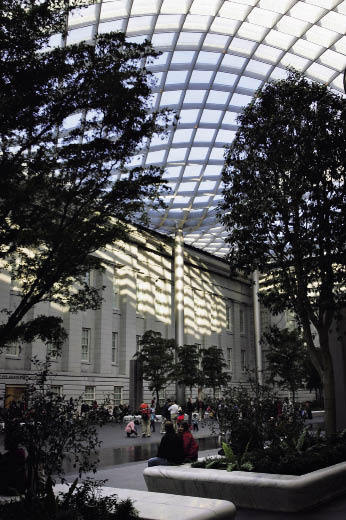The Great Court of the British Museum is a good place to start. Norman Foster brought light into the wonderfully elegant and inspiring glazed space at the heart of the museum where there had been nothing but greyness around the domed Reading Room. It also put Lord Foster of Thames Bank OM at the heart of the British cultural establishment.
Why don’t we know more about him? His creative achievement is enormous. He is 75 this year and his firm grows, employing over 1,000 people in 25 offices around the world. His clients include rulers of Middle Eastern oil rich states; the President of Kazakhstan; Commander Chen, responsible for all the new airports in China; Swiss banks and Russian oligarchs.
This book is the authorised biography, which rather puts it in the category of the approved corporate history. It avoids hagio- graphy but somehow it fails to explore in any depth what it is that inspires the architectural creative juices to flow? It is a difficult task to analyse such a huge built output and explain the workings of a giant practice that moves around the entire world like a superb and impersonal machine.
Deyan Sudjic is a thorough journalist and he gives us excessive detail about the early life of this misunderstood and unloved only child, raised in the deprived suburbs of Manchester. What emerges clearly is a silent and determined personality fascinated by futuristic technology; reading about Dan Dare and outer space in The Eagle; and somehow discovering Le Corbusier in the oasis of the public library. Surely young Norman must have been influenced more than we are told during his National Service in the RAF? Did he develop his fascination with flight and nurture his determination to train as an architect at Manchester University? The great liberation was getting to America (Foster flew, Richard Rogers went by sea) and meeting his hero architects at Yale. The gay Paul Rudolph and the almost sacred Louis Khan fed Foster’s imagination and banished the postwar cobwebs of Manchester. Norman Mailer may have thought these architects ‘isolated in a sea of empty psychosis’; but they were a potent influence on Foster and Rogers, and they instilled the idea that modern architecture was the only way to change society and the world.
Foster has never had the superficial glamour of Richard Rogers but he is much the better architect, and it would have been fascinating to explore the ambitions behind their twin careers in more detail. Instead Sudjic rightly explains that Foster’s approach to architecture is simply based on finding the best solution to a set of problems. The result is sometimes more routine than inspired. But his thorough approach can bring brilliant solutions, like the explosive interior of the Reichstag in Berlin and the calmly engineered beauty of the Pont Milau in the south of France. The shock of the initial closure of his Millennium Bridge in London because of a structural miscalculation is rather skated over. It was a great set-back to Foster — unfortunately he weathered it by blaming his engineers — but the public enthusiastically embraced his ‘blade of light’ bridge as a thrilling addition to the architecturally abused Thames.
Foster does, I believe, think that his buildings speak more clearly than his own words and this biography, which is weak on analysis of creativity, only provides a thin background story. It is poorly illustrated as a record of a life in architecture, and Foster remains as much of a glass iceberg as many of his buildings.
He graduated from flying gliders to piloting jets. He grew from the back streets of Manchester to the House of Lords. He has produced an architectural oeuvre of remarkably consistent quality and transformed professional international practice. He needed a biographer that could unmask the inspiring hero that he is and take him out of the hermetic world of architects. Foster is a phenomenon of out times but his official biographer has scarcely begun to discover him.






Comments